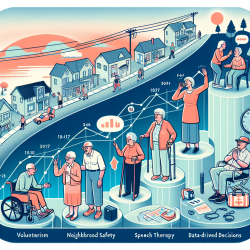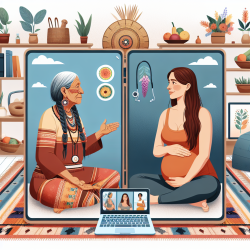Introduction
The intersection of perceived neighborhood safety and volunteerism offers intriguing insights, especially when considering its implications for older adults. The research article "Active Aging through Volunteerism: A Longitudinal Assessment of Perceived Neighborhood Safety as a Predictor among Older Adults, 2008-2018" provides a comprehensive analysis of this relationship. As practitioners in the field of speech-language pathology, understanding these dynamics can significantly enhance our approach to creating supportive environments for older adults, thereby indirectly benefiting children and other community members.
Key Findings from the Study
The study utilized longitudinal data from the Health and Retirement Study in the United States, encompassing a sample size of 72,319 adults aged 60 and older. The findings revealed that older adults who perceived their neighborhood safety as excellent were more likely to engage in volunteer activities. This trend was particularly pronounced among males and White respondents, while the results were not significant among Black respondents and those identifying as "other."
These findings underscore the importance of perceived neighborhood safety as a determinant of volunteerism, with implications for social capital and community engagement. The study suggests that improving neighborhood safety perceptions could foster increased volunteerism, yielding benefits at micro-, meso-, and macro-levels.
Implications for Practitioners
For practitioners, these insights offer several avenues for enhancing professional skills and client outcomes:
- Community Engagement: Encourage older adults to participate in community activities by addressing concerns about neighborhood safety. This can be achieved through collaboration with local authorities and community organizations to improve safety measures and perceptions.
- Program Development: Develop programs that leverage the social capital of older adults, such as mentorship opportunities for children, which can also improve intergenerational relationships.
- Research and Advocacy: Advocate for policies that enhance neighborhood safety and support volunteerism among older adults. Engage in further research to explore the nuanced effects of neighborhood safety on different demographic groups.
Encouraging Further Research
While the study provides valuable insights, it also highlights the need for further research, particularly in understanding the intersectional effects of gender and race on volunteerism and neighborhood safety perceptions. Practitioners are encouraged to explore these dimensions in their research and practice, contributing to a more comprehensive understanding of the factors influencing volunteerism.
Conclusion
By integrating the findings from this study into practice, speech-language pathologists and other practitioners can play a pivotal role in fostering active aging and community engagement. The benefits of volunteerism extend beyond individual well-being, enhancing community resilience and cohesion. As we strive to create supportive environments for all age groups, let us not overlook the valuable contributions of older adults.
To read the original research paper, please follow this link: Active Aging through Volunteerism: A Longitudinal Assessment of Perceived Neighborhood Safety as a Predictor among Older Adults, 2008-2018.










